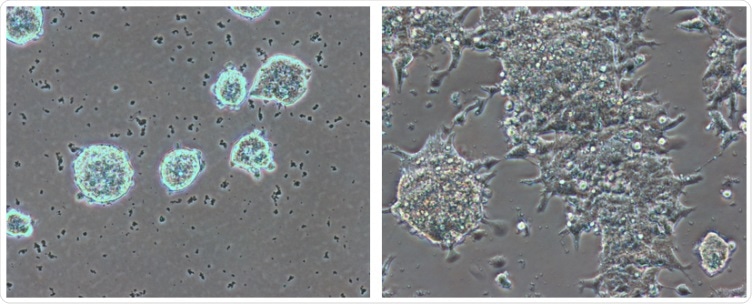Researchers from the Proteomics Core Unit of the Spanish National Cancer Research Centre (CNIO), led by Javier Muñoz, have explained novel mechanisms that play a role in maintaining the embryonic stem cells (ESCs) in the most optimized state for use in regenerative medicine.

Embryonic stem cells, in naïve state (left) and primed state (right). Image Credit: Centro Nacional de Investigaciones Oncológicas (CNIO).
Published in the Nature Communications journal, the study results will help identify new stem-cell therapies for heart disease, brain stroke, or neurodegenerative conditions, such as Parkinson’s or Alzheimer’s disease.
Naïve pluripotent stem cells, ideal for doing research
ESCs are essentially pluripotent cells that can develop into all types of somatic cells—a feature that is very useful for scientists and also in the field of regenerative medicine. There are two kinds of pluripotency called primed and naïve.
During embryonic development, the naïve state comes before the primed state. Naïve ESCs can differentiate into any type of cells; hence, they are more pertinent in studies. But the naïve state is not stable because naïve ESCs continuously receive signals that control the transition to the primed state and thus their self-renewal.
Interpreting the mechanisms that control the pluripotent states is significant because they could make it possible to maintain the stable naïve pluripotent stem cells in ESC cultures for a long time.
Conventionally, naïve ESC cultures are maintained based on the suppression of two of the signaling pathways that control the differentiation of cells—also called the 2i culture technique.
In the recent past, a new different method, called the inhibition of Cdk8/19, was used to maintain naïve ESCs. Cdk8/19 is a protein that controls the expression of various genes, such as the genes that help sustain the naïve state.
While the two approaches are used to culture naïve cells, little is known about the mechanisms involved.”
Javier Muñoz, Study Lead, Spanish National Cancer Research Centre
The CNIO team has now used proteomics—the large-scale characterization of proteins coded in a genome—to explain a vast number of the molecular events that help stabilize such valuable ESC.
This is the first time proteomics has been used in this context. We analyzed the mechanisms at a number of levels. First, we conducted phosphoproteomic analyses, studying phosphorylated proteins. Phosphorylation regulates protein functions (by activating or inhibiting them).”
Ana Martínez del Val, Study First Author, Proteomics Core Unit, Spanish National Cancer Research Centre
Martínez del Val continued, “Second, we analyzed the expression of these proteins. Finally, we identified changes in metabolites (reaction intermediates or end products). With our integrated approach, we got an accurate picture of the causes of the high degree of plasticity of ESC.”
The study results may have major implications for studies on certain cancer types. It is known that “the inhibition of Cdk8 leads to reduced cell proliferation in acute myeloid leukemia by enhancing tumor suppressors”, and that “Cdk8 is a colorectal cancer oncogene.”
Cdk8 activity is somehow enigmatic, since its functions vary considerably with the cell environment. We have identified a number of Cdk8 targets that were unknown until now. This can help understand the function this protein regulates in other biological contexts.”
Javier Muñoz, Study Lead, Spanish National Cancer Research Centre (CNIO)
Going beyond genomics with proteomics
The research work performed by the CNIO team highlights the need for a greater focus on proteomics, especially in cancer research techniques. Analyses of disease treatment have made a significant advancement in the past many years, thanks to the methods employed in molecular biology.
Two of the most commonly used methods are genomics—the study of the DNA sequence, the molecule that transports all the genetic data, and transcriptomics—the analysis of the sets of RNA transcripts, the molecules that change into proteins.
Proteins are essentially macromolecules that play a direct role in chemical processes crucial for life. Most recently, the proteomic method was implemented by biomedical scientists.
Over the last 15 years, proteomics has gained a great deal of traction and yet it has become vital for transcriptomics and genomics to come full circle. The processes of proteomics and genomics analyses, which occur before proteins, are produced.
Martínez del Val added, “We use proteomics to study a number of properties of proteins that cannot be analyzed by studying DNA or RNA.”
This is very important, as “proteins are responsible for a whole range of basic life functions that take place within cells,” Muñoz concluded.
Source:
Journal reference:
Martinez-Val, A., et al. (2021) Dissection of two routes to naïve pluripotency using different kinase inhibitors. Nature Communications. doi.org/10.1038/s41467-021-22181-5.